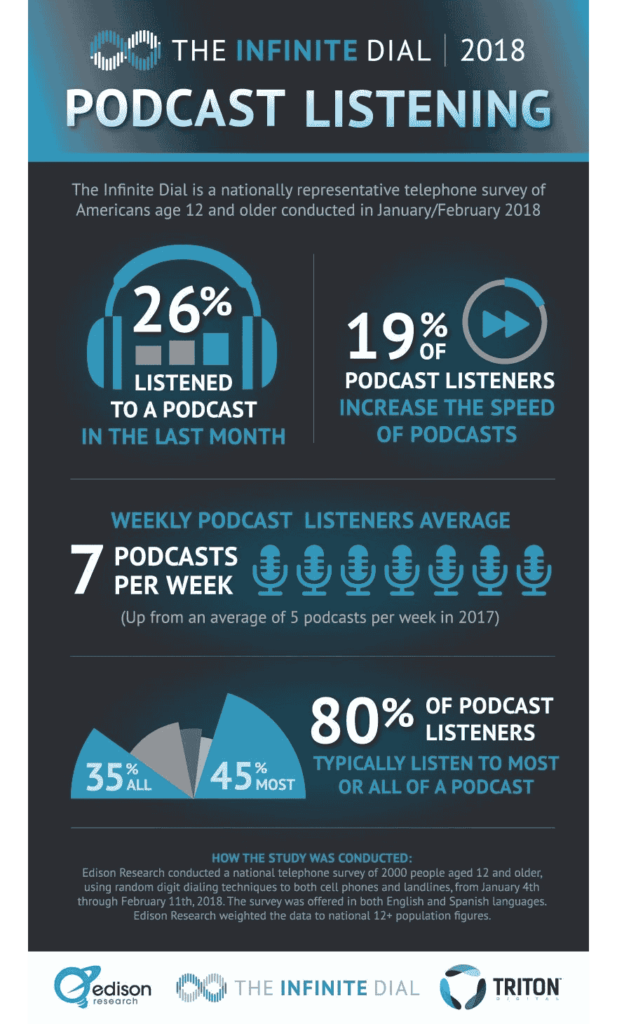The 5 Biggest Podcast Trends From 2018’s Infinite Dial Research
The annual release of the Infinite Dial research from Edison and Triton is like Christmas Day for the podcasting industry.
Everyone from podcasters to advertisers to audio platforms is clamoring for more data about the size of the industry, the demographics of the audience, and how podcasts are being consumed.
As of late last week, we’ve got fresh 2018 data. Here are the big headlines:

What does all this mean?
I talked to Tom Webster, Senior Vice-President at Edison Research, to analyze the data and to help identify the 5 big trends for podcasting.
1. In-Car Listening Surges With Connected Cars
In-car listening is golden. You can’t use a screen, commutes are getting longer, and you’ve got a captive audience on a recurring basis.
The car has long been dominated by AM & FM radio and that is still the case. Why? Radio is EASY. Hit a button and the radio just plays.
Podcasting in the car is NOT easy, especially if you’re tethering your phone via USB or connecting your phone to your car via Bluetooth. For many people, it’s just too much of a hassle.
Thanks to the highest ever annual increase of cars with in-dash, internet-powered entertainment systems, though, Tom says that may finally be starting to change.
“The reason why radio hangs on so much in the car, is it’s just so easy to use. You’ve got five presets and there’s what you’re going to listen to. Even though you have all of this content on your phone, it’s not easy to get to when you’re driving. The integrated in-dash entertainment system stat is going be the rate limiting factor on rapid growth in all things audio. As that spikes, I think everything else gets pulled up with it.”
It’s also fascinating to see podcasting overtake satellite radio in the car this year. Satellite radio has always been easier to use than podcasting and has had wider adoption in cars as as a result. This stat suggests that slowly, but surely, podcasting is getting easier to listen to in the car. (It also doesn’t hurt that podcasts are free…)
Takeways
- As more and more cars have connected in-car entertainment systems, listening to podcasts is getting easier (although it still has a long way to go to catch up to AM/FM…).
- Watch for a lot of experiments trying to make it easier to listen to podcasts during your commute.
2. Massive Smart Speaker Growth — What Does It Mean For Podcasts?
The astonishing growth of smart speakers in 2017 is perhaps this year’s biggest Infinite Dial headline.

“Smart speaker adoption is the fastest tech adoption we’ve ever tracked in the Infinite Dial. It went from 7 to 18% in a year. That ain’t nothing. That’s a lot of people.”
This growth is leading to a lot of experimentation and a lot of questions about the implications for podcast listening. Much like the car, though, podcasting faces one major obstacle in smart speaker land — it’s not easy to listen. Tom explains:
“The percentage of podcast listeners with smart speakers who say that they regularly listen to podcasts on their smart speakers is 24%. That’s really low. It should be high, theoretically it should be 100%. If you’re a podcast listener, why wouldn’t you be listening to a podcast on your smart speaker? It’s difficult right now, it’s too hard.”
Step one to making it easier for your podcast is discoverability. “I would make sure that my content was easy to find anywhere I wanted to find it and that includes the smart speaker.” In other words, don’t pick a show name that is similar to ten other popular podcasts — how will the smart speaker know which one to choose? And try not to pick a made-up name that can’t be recognized by voice assistants.
Brands in the audio space should also be thinking about how the unique opportunities that content listened to on a smart speaker present. “I would consider perhaps even natively doing different things on smart speakers compared to what I do on podcasts. You can certainly talk about skills.”
Context matters — promoting the use of a smart speaker ‘skill’ while listening to a podcast on your phone isn’t particularly useful. However, promoting a relevant and useful smart speaker skill while listening on a smart speaker could be really valuable for listeners and would likely be effective for the companies making the skills.
Takeaways
- Smart speaker growth isn’t slowing down anytime soon — they are replacing radios in the house.
- What can you do to make your podcast as easy as possible to find and listen to on these new devices?
- How should your audio content strategy change for consumption only on a smart speaker?
3. 7 Podcasts A Week For Weekly Listeners
People who love podcasts REALLY love podcasts. Audiences listen to all or most of 80% of the episodes they start. This is a huge number. It confirms that podcasts offer huge levels of engagement and that advertisers and brands should feel confident knowing that people are listening to their ads and their shows.
And it’s not just how much of an episode audiences listen to, it’s also how many episodes they are listening to. “The number of weekly podcasts listened to by weekly podcast listeners, it’s been five for a long time. To see it pop up to seven is a significant shift. That’s not one to ignore.”
The big question is why listening jumped so much this year. Tom thinks he’s got the answer:
“I do think it’s absolutely related to daily content. These daily podcasts are short. That doesn’t mean that shorter is better. That does mean that having a mix of shorter and longer is valuable for listeners. You have parts of your day where you may not have thought you can listen to a podcast, and now you can because here’s a 12-minute daily podcast. Having a mix of big rocks and little rocks in the podcasting jar is the key to increasing the overall number of podcasts consumed.”
For brands making podcasts, Tom suggests that there could lessons to learn from the success of the daily shows from the New York Times and NPR: “You might have a complete audio offering, which has longer pieces, but I would also look to find topical relevant ways to get the job done for brands in the shortest amount of time possible.”
Takeaways
- Can your brand provide useful, regular information that could be suited to a short-form daily podcast?
- Is your audio strategy all “big rocks”?
- Is there room for some strategic “small rocks” to fill your podcasting jar?
4. “49% Listen Most At Home”??? What Does That Mean?
Podcasting in generally seen as an solo listening endeavour. It’s not often a group activity. So every year, people are surprised to see that people listen to podcasts most at home. I know I have been confounded by this stat in the past, because it seems to suggest people sitting around in a living room or kitchen listening to podcasts together. So I asked Tom and — shocker — I was completely wrong:
“It’s the percentage of people who say that they listen most at home. That doesn’t mean they’re not listening in the car. That doesn’t mean that only 22% of listening is in the car. It means 22% of people say they listen most in the car. I wanna really be clear about that distinction.”
“That stat baffles a lot of people, they say, ‘People listen to podcasts walking around.’ That’s right, but where do they say they listen most? Are you at home more often than you are on a bus? Yes, you are. That’s really all that that stat says.”
“Now as far as how they’re listening to it, it’s almost overwhelmingly on their mobile phone. It might be between earbuds, it might be on a Bluetooth speaker, it might be on the phone’s speaker itself. It’s overwhelmingly on the mobile phone, but mobile phone doesn’t mean mobile location.”
Takeaway
- Don’t be fooled by the huge at-home listening stat.
- Podcasting is still mostly an individual listening activity and it’s primarily listened to on mobile phones.
5. Major Opportunities for Podcasting Growth
The data in this year’s Infinite Dial paints a familiar portrait — steady, ongoing growth with LOTS of room for future expansion of the market. As mentioned above, there are huge opportunities to make it easier to listen to podcasts in cars and on smart speakers. (Even though podcasts are essentially Netflix for radio, only 3% say that podcasting is their primary audio source in the car.) Tom points out another major gap — 36% of the population does not know what a podcast is.
“I think honestly the biggest mistake that podcast producers make is that they don’t promote their podcasts outside of podcasting. That’s what really holds everything back. There’s never been a mainstream effort, ever, to explain what a podcast is and why you’d want one.”
What are some other ways to bring the rest of the population into the world of podcasting? Simple. Make different types of podcasts.
“All you have to do is look at the top 25 Nielsen rated TV shows and look at the top 25 podcasts. They look nothing alike. There’s tons of content and opportunities, and tons of just huge demographic and psychographic swaths of people that are underserved by podcasts. They don’t know about them. They don’t know how to get them. Or they don’t know that the content is out there that they care about. And Android users are demographically quite different to iPhone users, and they’ve been underserved.”
Takeaways
- Growth in podcasting will come from people who have never listened to a podcast before.
- Watch for audio companies like iHeart Radio, ESPN, Spotify and others to be a gateway for first-time podcast listens with non-traditional podcast formats.
- Also watch for Google, Spotify, and others to make a concerted growth effort around potential Android listeners.
- Finally, watch for more and more ‘first podcast listens’ to come from brands — they often have huge reach and are a dark-horse source for new listener growth.
Do you have any other takeaways from this year’s Infinite Dial data? Let us know with a reply.
Thanks to Tom Webster for the insights and to Edison Research for this year’s Infinite Dial 2018 research. Get the full report here.
Sign up for the Pacific Content Newsletter: audio strategy, analysis, and insight in your inbox. Once a week.
